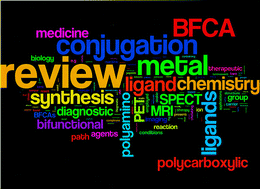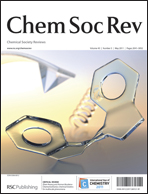The synthesis and application of polyamino polycarboxylic bifunctional chelating agents
Abstract
Bifunctional chelating agents (BFCAs) are molecules which contain two different moieties: a strong metal chelating unit and a reactive functional group. The latter is directed to react with amines, thiols, alcohols or other reactive molecules to form stable covalent bonds while the chelating moiety is able to strongly coordinate a metal ion. In this way, it is possible to label a molecule of interest (e.g. an antibody or a peptide) with a metal or a radioactive metal ion. Of all the ligands reported so far, those based on a polyamino polycarboxylic structure are most efficient and are widely employed for the chelation of metal ions. The resulting metal complexes have found a broad range of applications in chemistry, biology and medicine. Diagnostic imaging (MRI, SPECT, PET), molecular imaging, tumour therapy and luminescent materials are only a few examples. The present critical review gives an overview of the syntheses and most important applications of polyamino polycarboxylic BFCAs (334 references).


 Please wait while we load your content...
Please wait while we load your content...